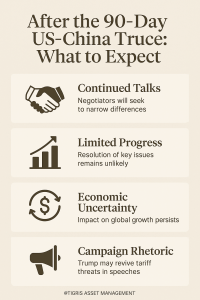
By Tigris Asset Management | May 2025
The recently announced 90-day pause in tariffs between the U.S. and China marks the first major trade move of the second Trump administration. While it offers short-term relief to businesses and investors, the underlying tensions between the world’s two largest economies remain unresolved. This is not a pivot — it’s a strategic recalibration.
Below, we break down what this truce signals, and what’s likely to follow.
What’s Driving the Pause?
- Market Stabilization: Aimed at reducing short-term uncertainty and preventing market overreaction during early 2025.
- Pressure Testing: Gives Washington time to observe Beijing’s willingness to engage while appearing measured.
- Inflation Management: Tariffs have contributed to elevated input costs; suspending them temporarily helps moderate inflation optics.
- Foreign Policy Realignment: This pause also offers time to coordinate broader Indo-Pacific trade and security strategies.
Likely Scenarios
1. Prolonged, Inconclusive Negotiation
A comprehensive deal remains unlikely. Issues like industrial subsidies, tech transfer, and market access are structural. Negotiations may yield phased agreements, but a grand bargain is improbable.
2. Continued Strategic Decoupling
Even if tariffs are suspended, the U.S. will likely push forward with export controls, investment reviews, and reshoring incentives — especially in strategic sectors like semiconductors, EVs, and defense tech.
3. Asia as a Beneficiary
Southeast Asia, India, and Mexico continue to benefit from supply chain diversification. The longer the U.S.-China tension persists, the more capital will flow toward “China-plus-one” hubs.
4. Selective Tariff Reinstatement
After 90 days, Trump may selectively reinstate tariffs on politically sensitive sectors — like steel, electronics, or vehicles — to reinforce negotiating leverage.
What It Means for Investors
- Don’t Price in a Reset: Markets may rally modestly, but don’t mistake this pause for normalization. Strategic distrust between the U.S. and China remains entrenched.
- Watch for Policy Asymmetry: China may respond with stimulus or countermeasures. Monitor capital flow restrictions, FX policy, and outbound investment rules.
- Reallocate Regionally: Southeast Asia, India, and LATAM markets remain best positioned to absorb trade and investment realignment.
- Track Commodities and Freight: If tariffs return, volatility in metals, manufacturing inputs, and shipping costs could spike again.
Conclusion
This 90-day pause is a tactical reset, not a turning point. It’s an opportunity to de-escalate — or to rearm with leverage. Investors should use this window to review exposure to global supply chains, reweight toward geopolitical beneficiaries, and remain vigilant on regulatory and inflation risks.
The U.S.-China rivalry is not easing. It’s evolving.
For more insights on global trade and investment strategies, visit our blog.


No Comments